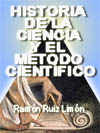
HISTORIA DE LA CIENCIA Y EL MÉTODO CIENTÍFICO
Ramón Ruiz Limón
Esta página muestra parte del texto pero sin formato
Puede bajarse el libro completo en PDF comprimido ZIP
(230 páginas, 2.88 Mb) pulsando aquí
The Scientific Method
A logical way of solving problems. Scientists use this method to gather and test information. There are seven steps to the scientific method:
1. Identify a problem (identificación y definición de un problema de investigación).
2. Create a hypothesis (diseñar una suposición o hipótesis preliminar)
3. Design an experiment
4. Conduct the experiment
5. Collect data (obtener datos empíricos, y teóricos que permitan contribuir a la descripción y explicación del problema de investigación).
6. Graph data
7.- Draw conclusions (obtener conclusiones a partir de datos)
8.- Informe de la investigación.
Here are the basic elements of a science research paper:
Title Page
Table of Contents
Abstract: The Abstract is a short summary of the project and includes the key highlights of your experiment: purpose, procedure, and conclusions. Following are some tips on writing your abstract from the California State Science Fair :
Objectives: State the purpose or hypothesis upon which the project is based.
Materials and Procedures: Indicate the materials and procedures used in your project. Briefly describe your experiment or engineering methods.
Results: Summarize the results of your experiment and indicate how they pertain to your purpose or hypothesis.
Conclusions/Discussion: Indicate if your results supported your hypothesis or enabled you to attain your objective. Discuss briefly how information from this project expands our knowledge about the category subject. If you did an engineering or programming project, state whether you met your design criteria.
Question and Hypothesis: The question that you are trying to answer with your experiment. Be sure to clearly state your hypothesis at the end.
Review of Literature: Background information that reflects the knowledge you have acquired, through your research, on the topic your of your experiment. You should be providing the reader with useful background information for your project.
Materials and Procedure (Research Plan): This is essentially your research plan. You should be certain to include a list of all materials that were used in your experiment and how they were used. It is best to present your procedure in steps and to include as much detail as possible about measurements and techniques in each step.
Results: A precise recap of what you found out in your experiment, focusing on your observations and data, leaving all interpretation for the Conclusion section.
Conclusion: A summary of your interpretation of the data and results of the experiment. You should restate the hypothesis and whether you found the hypothesis to be true or false. You should also comment on how the results of the experiment satisfied your original purpose.
Acknowledgments: This is your opportunity to thank anyone who helped you with your project, from a single individual to a company or government agency.
Reference List / Bibliography
Table and Figures: Include tables, charts, and photographs that further help explain your experiment and results.
TODO PROYECTO DE INVESTIGACION DEBERA CONTAR CON:
INTRODUCCIÓN
RESUMEN O ABSTRACT
CAPITULO I
PLANTEAMIENTO DEL PROBLEMA
1.1. ANTECEDENTES
1.2. DELIMITACIÓN DEL PROBLEMA
1.3. JUSTIFICACIÓN
1.4. OBJETIVO GENERAL Y OBJETIVOS ESPECÍFICOS.
1.5. DISEÑO Y CONSTRUCCIÓN DE HIPÓTESIS (PRELIMINAR. TRABAJO, DESCRIPTIVA, ANALÓGICA, NULA, ETC.)
CAPITULO II
MARCO TEORICO
CAPITULO III
- ENFOQUE EPISTEMOLOGICO O ESCUELA DE ALGUNA CORRIENTE FILOSOFICA (METODO CUALITATIVO O CUANTITATIVO).
- METODOLOGIA
- TECNICAS DE INVESTIGACION (PARA LA RECOLECCION DE LA INFORMACION EMPIRICA; CUESTIONARIOS, ENTREVISTAS, ETC.)
- CRONOGRAMA
- BIBLIOGRAFIA
- GLOSARIO DE TERMINOS
- ANEXOS
¿Cómo seleccionar un Tema o tópico de Investigación? ¿Cuál es el Problema que desea Resolver o Solucionar? ¿Cuáles son los elementos que forman parte del Problema?
Los objetivos se formulan, para establecer y definir, lo que se pretende alcanzar o conseguir. Dentro de ellos se contaran un Objetivo General y objetivos Específicos.
¿El investigador deberá de definir y precisar, cual es la meta o el fin del proyecto de investigación?
- Describir con precisión la naturaleza y características del fenómeno o hecho.
- Identificar y determinar el periodo de retorno o frecuencia con que ocurre o se presenta el fenómeno estudiado.
- Comprobar la Hipótesis en función de los Datos Empíricos y teóricos, asimismo identificar la relación causal entre las variables.
- Presentar los Juicios o proposiciones que sirven como argumentos y justificación del problema.
Por ejemplo:
A continuación se presenta el siguiente objeto de estudio sobre la neurosis en las mujeres de 20 a 30 años quienes se encuentran laborando como profesoras de educación primaria en la Ciudad X, y en el grado de segundo año grupo A y B respectivamente.
Las preguntas a las que tendría que dar respuesta la presente investigación serian las siguientes:
¿Cómo se desarrolla la Neurosis en las profesoras?
¿Qué tipos o clases de Neurosis se identifican en las profesoras? ¿Cuál es la Causa o factor (s) que producen la Neurosis?
¿Quiénes están propensos o pueden ser afectados por este Fenómeno o problema?
¿Cómo se puede evitar y ayudar a las personas que se encuentran afectados con este problema?
¿Qué niveles de neurosis existen en las profesoras?
¿Qué métodos psicológicos existen para el tratamiento de la neurosis?
¿Qué condiciones se requiere en las profesoras para que se genere la Neurosis?

